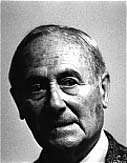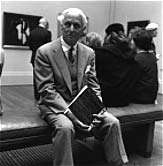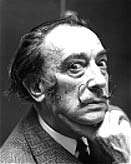 As World War I came to an end, the Dada movement evolved into a new movement called Surrealism. This medium of art created a palette of purity and hope though automatism and use of dreams. The Surrealists strove for simplicity and spontaneity or as some called it, automatism. They wanted to answer the question "how shall I be free?" and to express thought without any tainted preconceptions. They believed automatism "would reveal the true and individual nature of anyone who practiced it, far more completely than could any of his conscious creations. For automatism was the most perfect means for reaching and tapping the unconscious." (Stangos 125) This free style of expression, first used in literary circles headed by Andre Breton and then by painters like Max Ernst, Joan Miro, Salvador Dali and René Magritte, upheld the Dadaist rejection of traditional forms of art. However, by portraying a field of unconscious thought and thereby, following an uncontaminated reality, the surrealists avoided the horrors of premeditated warfare and political, social and economic lies and injustices. Surrealist theorists found Surrealism to be:
As World War I came to an end, the Dada movement evolved into a new movement called Surrealism. This medium of art created a palette of purity and hope though automatism and use of dreams. The Surrealists strove for simplicity and spontaneity or as some called it, automatism. They wanted to answer the question "how shall I be free?" and to express thought without any tainted preconceptions. They believed automatism "would reveal the true and individual nature of anyone who practiced it, far more completely than could any of his conscious creations. For automatism was the most perfect means for reaching and tapping the unconscious." (Stangos 125) This free style of expression, first used in literary circles headed by Andre Breton and then by painters like Max Ernst, Joan Miro, Salvador Dali and René Magritte, upheld the Dadaist rejection of traditional forms of art. However, by portraying a field of unconscious thought and thereby, following an uncontaminated reality, the surrealists avoided the horrors of premeditated warfare and political, social and economic lies and injustices. Surrealist theorists found Surrealism to be:
"a certain point of the mind at which life and death, the real and the imaginary, the past and the future, the communicable and the incommunicable, the heights and the depths, cease to be perceived contradictably.
Now it is in vain that one would seek any other motive for Surrealist activity than determining this point. (Stangos 134)"
By using one"s unconscious mind, "the imagination in a primitive state," (Stangos 126) Surrealism found a place where contradictory thoughts might not serve as dichotomies. Free of a socially constructed point of view or "raison", a writer or artist travels to a place of thinking that is both irrational and rational at the same time. Through the unconscious or a highly sensitized state of mind, the surrealist brought forth a new manner of seeing and feeling the world as it was understood and negotiated by Western peoples.
Joan Miro
In its development, Surrealism celebrated the art of children, mad people and primitive art. The Surrealists believed in the innocent eye. They found that art produced by young children was more real than that produced by adults-- since the art of adults was usually repressed and contaminated. The Surrealists often played children"s games like the one where each player draws a head, body or legs then folds the paper after his turn so that his contribution is not seen. The strange images resulted (Joan Miro) and others with inspiration for works, such as “The Harlequin"s Carnival”. (Stangos 127)
Max Ernst
In addition to this technique, Max Ernst, in 1925, began using a child"s technique which led him in his direction of art for the next two decades. The technique was termed frottage, or "rubbing". It involved placing a piece of paper over a textured surface and then rubbing it with a pencil to record the texture. Afterwards, the images produced would be rearranged and the results were new images and associations from these initial rubbings. These images would then go on to become inspiration and the groundwork for paintings and sculptures.
Ordinary forms and objects were used to create art. The Surrealists saw an object and created art out of it because of the feelings that object inspired or what that object lent itself to be transformed into. As Miro said, "I begin painting, and as I paint the picture begins to assert itself, or suggest itself, under my brush. The form becomes a sign for a woman or a bird as I work." As a result of these ideas, flea markets boomed because they were the homes of inspiration and otherwise useless objects, perfect for the art of the Surrealists.
Miro was an artist that took advantage and used to full potential the opportunities simple forms offered him.
Miro would often start his canvases with random washes and then build upon the forms generated by the sponges, rags or burlap he used. After he had something down on the canvas, the forms would inspire Miro to carefully work to a full production. As he states, "the first stage is free, unconscious, but the second stage is carefully calculated." (Stangos 130) Miro was not really a product of Surrealism but was rather a necessity for its beginning. Surrealism needed his work in order to define itself as an art movement. Breton said "by his "pure psychic automatism" Miro might "pass as the most Surrealist of us all."" (Stangos 130)
In addition to the childlike innocence the Surrealist sought, Miro looked into his dreams and into his childhood for ideas for his art. The Surrealists looked towards dreams because they believed dreams were thoughts and imaginations in the primitive state. Dreams were part of the unconscious, and the unconscious was untainted. In the beginning of the Surrealist period, artists used hypnotism and drugs to venture into the unconscious state to extract images, word and ideas. Andre Breton said that these images and feelings could not be had in the conscious state. Quite often, the Surrealists would create dream-like scenes and scenarios which would otherwise be impossible in the natural world.
Salvador Dali
Salvador Dali once said the only difference between himself and a madman was that he was not mad. His paintings were often a bizarre and erotic dream world influenced by dreams and his fear of sex. Dali painted with a photographic like accuracy and used bright intense colors that made his works look alive. However, his subjects were obviously static because of the dream like scenes surrounding them. He described the theoretical basis of his paintings as "paranoiac-critical": the creation of visionary reality from elements of visions, dreams, memories and psychological or pathological distortions through the use of familiar objects such as watches, insects and telephone and the primary images of blood decay and excrement. (Wheeler 291) Dali’s images gradually transformed into visual nightmares such as melting watches in “The Persistence of Memory”.
Like the impossibilities of Dali"s scenes, René Magritte painted reality with an illusionistic twist. In The Human Condition and other works, Magritte uses illusion to fool the eye into thinking something is what it really is not.
In The Human Condition, the eye is fooled into believing that the painting is of a landscape being viewed through a window. In reality, the painting is of a painting on an easel in front of a window containing the view outside that window. Magritte also demonstrates this illusionistic quality in The False Mirror where the iris of the painted eye is filled with a sky scene.
"As beautiful as the chance meeting on a dissecting table of a sewing machine and an umbrella" (Stangos 126) is a quote that basically sums up the principles surrounding Surrealism. It is this type of dream like scene that the Surrealists were seeking-- pure, untainted and spontaneous.
artworks:
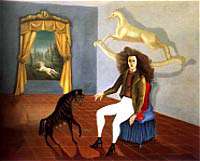 |
| Leonora Carrington: Selvportræt, 1938 |
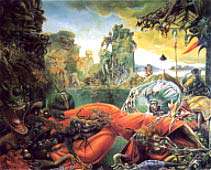 |
| Max Ernst (1891-1976): "Temptation of St. Anthony", 1945 |
 |
| Salvador Dali (1904-1989): Metamorphosis of Narcissus, 1937 |
Also it is recommended to see:
